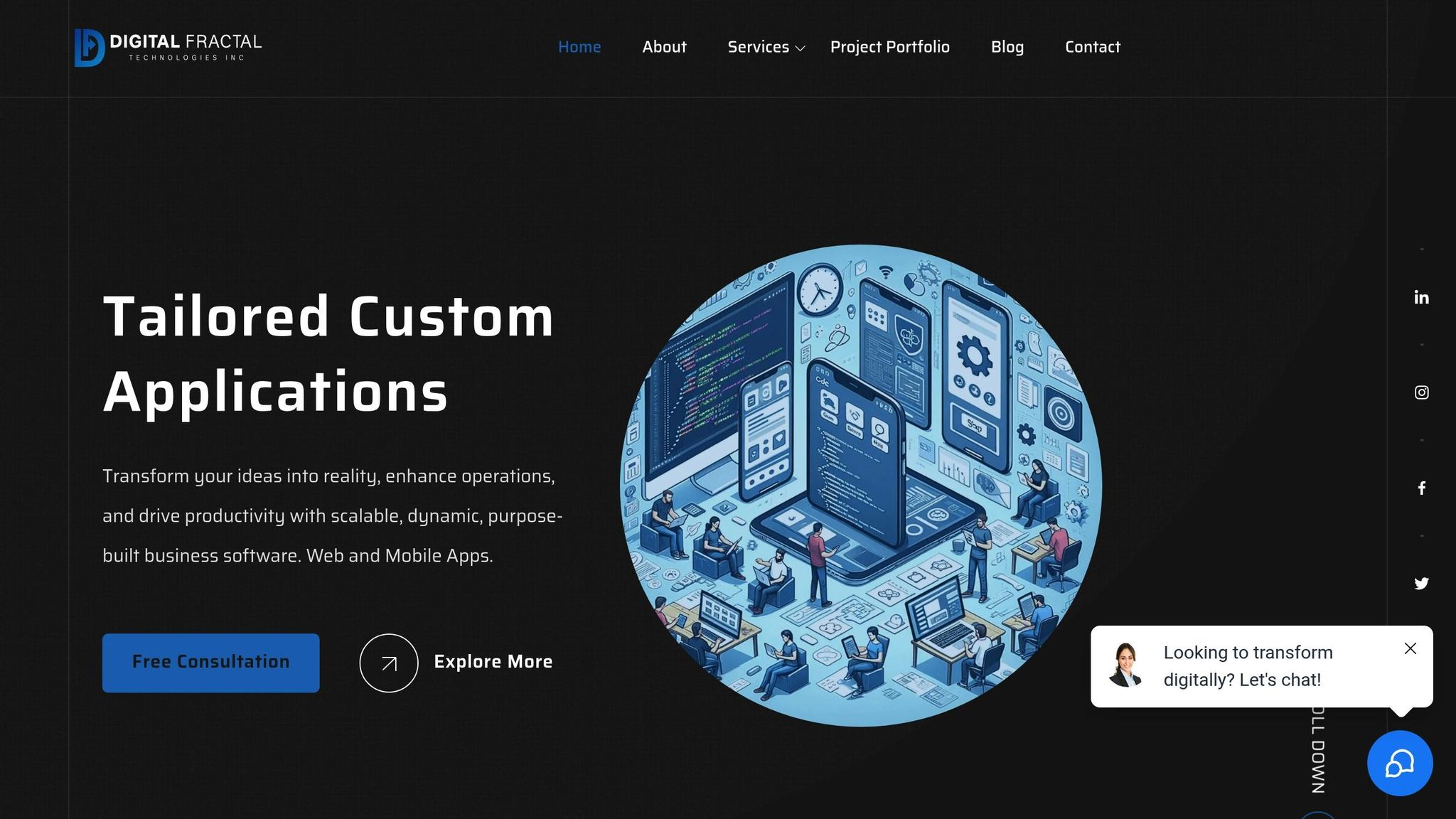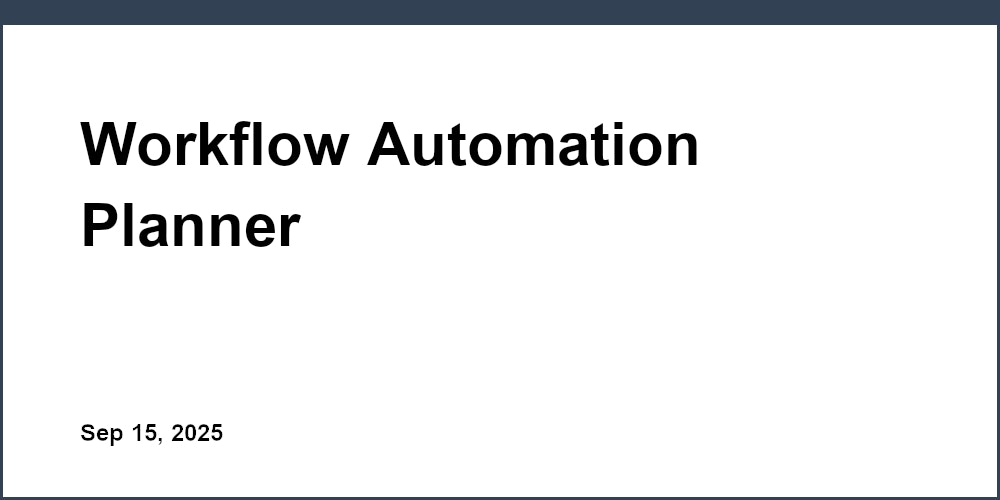
Complete Guide to Business Process Automation
Business Process Automation (BPA) uses AI-based tools to handle repetitive tasks with minimal human effort. For Canadian businesses, BPA improves efficiency, reduces costs, and ensures compliance with federal and provincial regulations. It simplifies processes like data entry, customer service, and reporting, while also supporting consistent service across time zones.
Key Takeaways:
- Benefits: Cost reduction, fewer errors, faster workflows, easier compliance, and better customer service.
- Technologies: Robotic Process Automation (RPA), AI, Machine Learning (ML), Natural Language Processing (NLP), cloud computing, and low-code platforms.
- Implementation Steps:
- Map current workflows to identify inefficiencies.
- Set measurable goals (e.g., cost savings, error reduction).
- Start with small pilot projects and scale gradually.
- Choose tools that integrate with existing systems (ERP, CRM, HRIS).
- Train employees and monitor performance.
Digital Fractal Technologies Inc. specializes in custom BPA solutions for Canadian businesses, ensuring tailored tools that align with operational needs. Their success stories, such as transforming Xtreme Oilfield’s manual processes into efficient digital workflows, highlight BPA’s potential to improve productivity while meeting Canada’s stringent data and security standards.
BPA is reshaping industries like energy, healthcare, and construction by automating workflows, enhancing service quality, and addressing compliance challenges. Starting small and involving employees ensures a smoother transition to automation, helping businesses remain competitive in a dynamic market.
Key Components and Technologies in BPA
Core Technologies in BPA
At the heart of Business Process Automation (BPA) are technologies that simplify and enhance operations, ranging from simple task automation to sophisticated systems capable of learning and adapting.
Robotic Process Automation (RPA) is one of the main players, using software robots to replicate human actions within digital systems. These bots excel at repetitive tasks like data entry, invoice processing, and report generation, working tirelessly to handle high volumes of transactions.
Artificial Intelligence (AI) and Machine Learning (ML) add a layer of intelligence to automation. These tools can spot patterns, make predictions, and adjust as they process new information. Whether it’s categorizing customer inquiries, forecasting maintenance needs, or fine-tuning supply chains, AI and ML push automation to the next level.
Natural Language Processing (NLP) equips systems to understand and respond to human language. This technology powers chatbots for customer service, automates the review of legal documents, and extracts critical details from communications.
Cloud computing has made automation more accessible by eliminating the need for heavy IT investments. Businesses can now deploy advanced automation tools via cloud-based platforms, avoiding the costs of on-site hardware and infrastructure.
Workflow orchestration technologies ensure tasks flow smoothly across departments. When one task is completed, these systems automatically trigger the next, keeping processes efficient and aligned.
Low-code and no-code platforms make automation more accessible to non-technical users. These tools allow employees to design and update automated workflows without needing advanced programming skills.
While these technologies are the foundation of BPA, their real power lies in how they integrate with existing systems. When combined, they help Canadian businesses streamline operations and boost efficiency.
Integration with Existing Systems
For BPA to be truly effective, it must work seamlessly with the systems businesses already rely on. Many organizations in Canada use tools like Enterprise Resource Planning (ERP), Customer Relationship Management (CRM), and Human Resources Information Systems (HRIS). Ensuring smooth integration with these systems is critical to extending their functionality.
Application Programming Interfaces (APIs) play a key role in connecting BPA tools with existing software. For example, when a customer places an order online, APIs can automatically update the ERP system’s inventory, generate a shipping label, and send a confirmation email – all without human intervention.
Database connectivity ensures data remains consistent across platforms. This eliminates the need for manual data transfers, reducing errors and helping businesses stay compliant with Canada’s regulatory standards.
Business Process Automation: What We’ve Learned From 250 Projects
Step-by-Step Guide to Implementing BPA
Getting started with Business Process Automation (BPA) requires thoughtful planning and practical steps. The best approach? Start small, learn from each step, and gradually extend automation across your organisation.
Analysing Current Processes
Before diving into automation, it’s crucial to understand how things currently work. Begin with process mapping – break down every task, decision point, and handoff in your workflows. This will help you spot bottlenecks and inefficiencies.
Bring your team together and examine each step of the process in detail. Ask questions like: How long does each task take? Where do delays typically occur? Which steps require the most manual effort? Document everything – from the tools and people involved to the time spent on each activity.
To dig deeper, consider conducting time-motion studies. These studies can quantify the time employees spend on repetitive, manual tasks. Look for processes that are rule-based, repetitive, and involve structured data – such as invoice processing, onboarding new employees, or updating inventory. Avoid starting with tasks requiring human judgment or unstructured data until you’ve gained more experience with automation.
Compile your findings into a process inventory. Include key details like current workflows, time measurements, error rates, and resource requirements. This inventory will serve as a baseline for tracking improvements after automation is introduced. With these insights in hand, you can set clear, measurable goals for automation.
Setting Goals and KPIs
Next, define SMART objectives (Specific, Measurable, Achievable, Relevant, Time-bound) that align with your organisation’s priorities and justify the investment in automation.
For efficiency, focus on metrics like reducing time and costs. For example, you might aim to significantly cut processing times or lower operational expenses based on your process analysis.
Improving quality is just as important. Set targets for reducing errors, enhancing compliance, or boosting customer satisfaction. This might include achieving higher accuracy in order processing or faster response times for customer inquiries.
Don’t overlook financial metrics – they’re essential for demonstrating returns on investment. Highlight potential savings from reduced labour costs, fewer errors, and faster processes. You can also track employee satisfaction to ensure automation allows staff to focus on more meaningful, value-driven tasks.
Create a measurement framework that includes baseline metrics, specific targets, and a schedule for regular reviews. Periodic assessments will help you fine-tune your strategy and celebrate progress along the way.
Implementing and Optimising Automation
With goals and KPIs established, it’s time to implement automation. Start small and refine your approach as you go.
- Begin with pilot projects. Choose a straightforward process with clear success criteria – one that won’t cause major disruptions if challenges arise. This gives you the chance to test and adjust your methods before tackling more complex tasks.
- Choose the right automation tools. Look for solutions that fit your organisation’s needs and technical capabilities. Consider factors like ease of integration, scalability, user-friendliness, and support options. Cloud-based tools often offer quicker deployment and lower upfront costs.
- Address change management proactively. Be transparent with employees about the goals of automation and how their roles might evolve. Highlight how automation will handle repetitive tasks, freeing them to focus on more engaging, high-value work.
- Provide hands-on training. Offer practical, role-specific training to help employees adapt to new tools and processes. This builds confidence and ensures a smoother transition.
- Roll out automation in phases. Start with a small group of users, gather feedback, make adjustments, and then gradually expand the rollout. This phased approach minimizes risks and allows for quick problem-solving.
- Monitor and optimise continuously. Track your KPIs closely and stay alert for any issues, such as bottlenecks or user adoption challenges. Look for additional opportunities to refine and enhance the automated processes.
- Create feedback loops. Set up channels for employees to report issues and suggest improvements. The input from those using the systems daily can offer valuable insights for ongoing adjustments.
As you scale automation, maintain strong governance practices. Keep your process documentation up to date, establish change control procedures, and develop disaster recovery plans. These steps ensure quality and compliance as automation expands across your organisation.
sbb-itb-fd1fcab
AI-Driven Solutions by Digital Fractal Technologies Inc

Digital Fractal Technologies Inc stands out in the Canadian business process automation (BPA) landscape by offering custom-built solutions that go far beyond generic automation tools. Their focus is on creating purpose-built applications that seamlessly integrate with existing systems, addressing the specific challenges faced by Canadian businesses. This approach ensures tools that are tailored to unique operational needs, with flexible pricing and a proven track record of success.
Custom BPA Tools and Features
Digital Fractal develops automation tools that align precisely with how your business operates. Instead of trying to adapt generic software to your workflows, they design custom mobile and web applications that fit your processes perfectly.
Their expertise covers several critical areas that make automation effective:
- AI consulting services: Leveraging machine learning and computer vision technologies to tackle complex data processing tasks.
- Workflow automation: Connecting systems and processes for smooth, end-to-end operations.
- Legacy app migration and support: Bridging integration gaps to maximize the value of existing systems while introducing new automation features.
Data security and privacy are a top priority. Digital Fractal ensures all solutions comply with Canadian data regulations, keeping sensitive information within the country. Their data sovereignty approach aligns with strict privacy requirements, giving businesses peace of mind.
Security is embedded into every solution from the start. Their cybersecurity services include threat prevention, detection, and 24/7 monitoring. This proactive approach helps prevent breaches before they happen, ensuring systems remain secure and reliable.
Service Plans and Pricing
Digital Fractal understands that every business has unique needs and budgets. That’s why they offer custom quotes tailored to your specific requirements, rather than forcing you into pre-set packages.
Their services are structured to support businesses at various stages of their automation journey:
- Basic Development: Ideal for businesses starting with automation. Services include mobile and web app development, UI/UX design, and API integrations to connect existing systems.
- Advanced AI: Designed for companies ready to implement sophisticated automation technologies like machine learning, computer vision, AI chatbots, and comprehensive workflow automation.
- Enterprise Suite: A complete digital transformation solution. This includes custom CRM development, business management tools, legacy system migration, and ongoing support.
All pricing is in Canadian dollars, making it straightforward for Canadian businesses to budget. The custom quote approach ensures you only pay for the features you need, delivering solutions that directly address your challenges.
Success Stories and Client Impact
Digital Fractal’s work with Canadian businesses highlights the tangible benefits of their automation solutions. A prime example is their partnership with Xtreme Oilfield, a leading Canadian energy service company.
Before collaborating with Digital Fractal, Xtreme Oilfield managed their trucking operations with manual, paper-based processes, which led to inefficiencies, increased errors, and challenges in tracking performance and compliance.
Digital Fractal developed a comprehensive mobile app and web backend system for Xtreme Oilfield. This solution automated critical tasks like certificate and permit management, job dispatching, and timesheets. It also digitized vehicle repair tracking and field communications, bringing these functions directly to workers’ iPads.
"Digital Fractal Technologies Inc. digitally transformed the trucking operations for Xtreme Oilfield, a leading Canadian energy service company. Prior to this, most processes were manual and paper-based. The developed Xtreme Oilfield mobile application and web backend system digitized paper forms, automated certificate/permit management, computerized job dispatching, and brought timesheets, vehicle repair, and communications to the field on an iPad."
This transformation eliminated paper forms entirely, reduced processing times, and provided real-time visibility into operations – something that previously required manual reporting and data compilation.
The success with Xtreme Oilfield is a testament to Digital Fractal’s ability to tackle complex integration challenges while maintaining the high standards of security and reliability required in sectors like energy. Their solutions don’t just automate tasks – they rethink processes to make them more efficient and effective for Canadian businesses.
Industry Use Cases and Current Trends in Canada
BPA Use Cases in Canadian Industries
Businesses across Canada are reshaping their operations by integrating automation into various sectors, each with its own set of challenges and opportunities. Here’s how different industries are using automation to drive efficiency and improve outcomes:
Energy and Natural Resources
This sector, a cornerstone of Canada’s economy, has adopted automation to tackle operational complexities while adhering to rigorous safety and compliance standards. Mobile automation solutions are transforming field operations – workers now access real-time data, submit digital reports, and ensure compliance without the delays caused by paper-based processes. This shift has streamlined workflows and reduced administrative burdens.
Public Sector
Government organisations at both provincial and municipal levels are leveraging automation to enhance citizen services while working within tight budgets. Automated systems for permit processing, digital document management, and service portals are cutting processing times from weeks to just days. This allows staff to dedicate their efforts to more complex, human-focused tasks that technology cannot handle.
Construction and Infrastructure
Automation is revolutionising project management in construction. Tools like automated scheduling systems ensure better coordination between trades and equipment, while digital inspection platforms help maintain consistent quality standards. These solutions are especially beneficial for large-scale infrastructure projects where seamless collaboration among multiple stakeholders is critical.
Healthcare
Canadian healthcare providers are turning to automation for patient scheduling, inventory management, and regulatory reporting. These systems simplify compliance with healthcare regulations and improve patient experiences by reducing wait times and streamlining appointment coordination.
Current Trends in Automation
As automation proves its value across industries, several emerging trends are shaping its future in Canada:
Hyperautomation
Canadian businesses are moving beyond isolated automation tools to fully integrated systems that automate entire workflows. By combining technologies like AI, machine learning, and robotic process automation, companies are achieving greater efficiency and simplifying the management of complex processes.
AI-Powered Decision-Making
AI is enabling businesses to analyse intricate data patterns and make autonomous decisions within set parameters. This is particularly impactful in sectors like finance and logistics, where quick, data-driven decisions can make a significant difference in outcomes.
Green Automation
With sustainability becoming a priority, Canadian companies are adopting automation solutions that minimise energy use, reduce waste, and support environmental reporting. These efforts align with Canada’s climate goals and help businesses comply with stricter environmental regulations.
Mobile-First Automation
As remote and hybrid work models become standard, automation tools are being designed to function seamlessly across devices. Whether employees are in an office, at home, or out in the field, mobile-friendly systems ensure they can manage processes from anywhere.
Industry-Specific Solutions
Rather than relying on generic tools, businesses are opting for automation systems tailored to their industry’s unique needs. This shift recognises that effective automation should complement existing workflows rather than forcing companies to adapt to rigid software designs.
Overcoming Challenges in BPA Adoption
While automation offers clear advantages, businesses often face hurdles during implementation. Here’s how Canadian companies are addressing common challenges:
Employee Resistance
Concerns about job security and unfamiliar technology are common. To address this, businesses involve employees early in the process, clearly explain how automation supports their roles, and provide hands-on training. The goal is to show that automation handles repetitive tasks, freeing employees to focus on strategic and creative work.
Integration with Legacy Systems
Many Canadian companies rely on older systems that can’t be replaced overnight. Custom integrations that connect legacy software with modern tools allow businesses to modernise gradually while preserving their existing investments.
Budget and Skills Gaps
Smaller businesses often struggle with limited budgets and a lack of technical expertise. Starting with simple, high-impact processes that deliver quick results is a practical way to build momentum. Partnering with local technology providers for ongoing support also helps bridge skills gaps.
Regulatory Compliance
Industries like healthcare, finance, and energy face strict regulations that add complexity to automation projects. Engaging compliance experts from the start ensures that automated processes meet all legal requirements without sacrificing efficiency.
Conclusion: The Way Forward with BPA
Business process automation (BPA) is reshaping how Canadian organisations operate and compete in today’s fast-paced market. Whether it’s energy companies improving field operations or healthcare providers shortening patient wait times, automation has shown its ability to streamline workflows while preserving the human touch that matters most.
For businesses, automation isn’t just about saving money – it’s about positioning themselves for long-term success. By combining AI-powered decision-making with mobile-first solutions, companies across Canada are unlocking new opportunities for growth and efficiency. What makes automation stand out is its capacity to free employees from routine tasks, allowing them to focus on strategic, high-value work. At the same time, it ensures compliance with the strict security and regulatory standards Canadian businesses require. From construction firms managing complex projects to municipal governments processing permits faster, automation enhances human potential rather than replacing it.
The key to success lies in starting small, focusing on high-impact processes, and involving employees from the beginning. Partnering with experts who understand both technology and business needs also plays a critical role in ensuring smooth implementation. Companies that adopt this thoughtful approach often achieve the most meaningful and lasting results.
To navigate this transformation, expert guidance can make all the difference. Digital Fractal Technologies Inc is well-equipped to support Canadian businesses on their BPA journey. With their deep expertise in custom software development, AI consulting, and workflow automation, they deliver tailored solutions designed to meet the needs of growing companies. Their experience across industries such as the public sector, energy, and construction means they understand the specific challenges Canadian organisations face, from navigating regulatory requirements to managing tight budgets.
As highlighted throughout, the future belongs to organisations that can adapt quickly without sacrificing quality. BPA, with its integration of AI-driven and mobile-first technologies, ensures operational excellence while improving customer experiences. With a well-planned BPA strategy – like those offered by Digital Fractal Technologies Inc – Canadian businesses can gain a lasting competitive edge in an ever-evolving market.
FAQs
How can Canadian businesses seamlessly integrate business process automation tools with their existing ERP and CRM systems?
For Canadian businesses looking to integrate business process automation (BPA) tools with their ERP and CRM systems, a proper game plan is essential. Start by carefully evaluating your current systems to pinpoint specific integration requirements. Pay close attention to data standardization – this means ensuring formats for currency (like CAD), dates (DD/MM/YYYY), and measurement units align with Canadian standards. This step helps prevent compatibility issues that could derail the process.
Another critical step is data cleanup. Before diving into integration, address any inconsistencies or duplicate records to ensure a smoother transition. Using reliable integration platforms or middleware can make it easier to share and sync data across systems. Real-time data exchange should also be a priority to keep operations running seamlessly, while robust security measures are necessary to safeguard sensitive information.
Lastly, don’t overlook the importance of involving key stakeholders. Bring them into the planning and testing stages to ensure the integration aligns with business objectives and causes minimal disruption during rollout.
What challenges do Canadian businesses face when adopting business process automation, and how can they address them?
Canadian businesses face a variety of hurdles, including meeting strict compliance standards, keeping up with fast-changing technologies, and addressing employee resistance to change. On top of that, regulations like privacy laws and data security requirements add another layer of complexity to automation efforts.
To tackle these challenges, businesses should focus on thoughtful planning and employee education to make transitions smoother. Compliance with Canadian laws, such as the Personal Information Protection and Electronic Documents Act (PIPEDA), is a critical step. Starting with smaller automation projects that deliver quick, meaningful results can help showcase their benefits, boost confidence, and set the stage for larger-scale initiatives.
How can business process automation help Canadian companies meet regulatory requirements and boost efficiency?
Business process automation helps Canadian companies stay on top of regulatory requirements by taking over repetitive, rule-based tasks. This not only reduces the chance of human error but also ensures consistent compliance with key regulations, such as Quebec’s Law 25 and Canada’s Directive on Automated Decision-Making.
It also simplifies compliance tasks like monitoring, reporting, and conducting risk assessments. By boosting accuracy and efficiency, automation allows businesses to shift their focus to strategic goals while still meeting complex regulatory demands.

